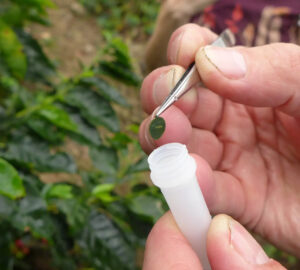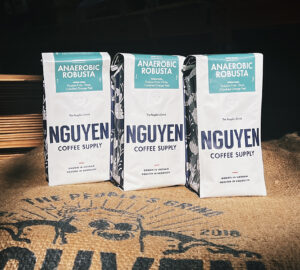What is Robusta coffee?
Robusta coffee (be it a bean, brewed in the cup, or the plant itself) refers to coffee that comes from the plant species Coffea canephora. Coffea canephora is one of the two primary species of coffee plants cultivated around our world, the other being Coffea arabica, or “Arabica” coffee, of which Coffea canephora, along with Coffea eugenioides, is actually a parent.
Though Arabica used to dominate global coffee production over Robusta by a wide margin—around 80/20—these days, Robusta now makes up a little more than 40% of coffee grown worldwide, according to World Coffee Research. Though Robusta has often been held to be of a “lower” quality than Arabica coffee, it is considerably easier to grow and is often more tolerant of disease and drought. In these ways, it is a more “robust” coffee plant than its sister species. Not incidentally, it also has more caffeine than Arabica by nearly twice as much.
Where did Robusta coffee originate and where is it grown now?
Robusta coffee’s origins lie in Africa, where it was identified in the 1800s in the sub-Saharan regions in the western and central parts of the country such as the Democratic Republic of Congo (then the Belgian Congo) and Uganda. It is still grown today in Africa as well as in Asia (including Indonesia and India, but production is especially high in Vietnam.) Brazil, too, produces a large amount of Robusta coffee. In addition, Robusta is able to grow well at lower altitudes than Arabica coffee, expanding its geographic possibilities.
Why does Robusta get such a bad rap?
Ask any coffee aficionado and you’ll likely get the same answers about Robusta: Robusta coffee is more bitter and acrid than Arabica, often tasting of burnt rubber, and evoking one’s worst memories of gas station coffee. But is this a hard and fast rule? Not necessarily—or rather, it doesn’t have to be. Due to Robusta’s history of being cultivated for lower-end markets, the care and attention we see paid to processing in Arabica farming are not commonplace with Robusta. Higher quality Robustas are possible, though still likely to have more of the flavor characteristics (like low acidity and more bitterness) we expect. But as a blend component, for instance, higher quality Robustas have the potential to take espresso to the next level.
What are some varieties of Robusta coffee?
The main varieties of C. canephora, which we colloquially call Robusta, are Erecta and Nganda, which describe a tall-standing coffee shrub and a wide-spreading shrub, respectively. More interestingly may be Robusta’s descendants. Besides spawning Arabica itself, Robusta and Arabica coffee plants have spontaneously cross-bred in the wild, which led to the Timor hybrid’s emergence in the first half of the 20th century.
Some of today’s hybrid coffee varieties which are still considered Arabica, like Catimor and Sarchimor, incorporate genetic material from Robusta coffees that allow the plants to be more disease-resistant, at least for some period of time. With the threat of coffee leaf rust and other environmental concerns jeopardizing the future of coffee, it will be important to continue research into hybrids like these to ensure coffee production is able to survive.
Is Robusta ever blended with something else?
Arabica-Robusta blends are still common, especially for espresso, where Arabica beans are selected for flavor while Robusta beans are added to enhance caffeine, intensity, and crema. Robusta is still favored for Italian-style blends in particular, where the flavor profile is consistent with Italian espresso’s traditional flavor expression.
Liz Clayton is the associate editor at Sprudge Media Network. Read more Liz Clayton on Sprudge.

















![[digital version] coffee varieties poster 24x36](jpg/wcr-poster-300x270.jpg)












